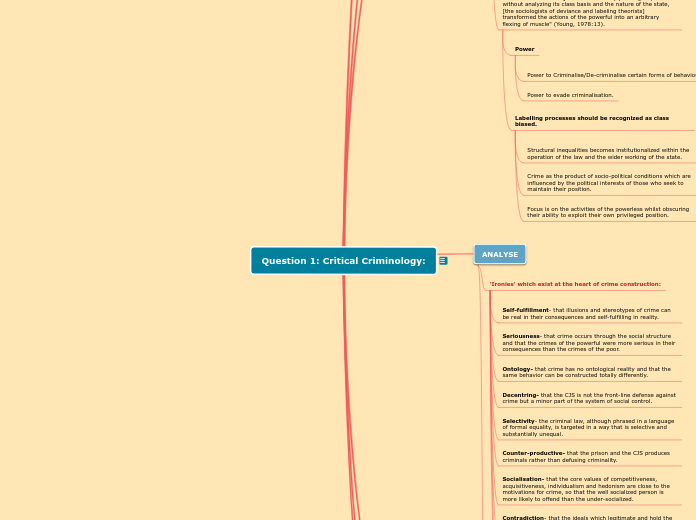PROVIDE THE EVIDENCE TO ANALYSE AT LEAST ON OF THESE ALLEGED 'IRONIES'
Question 1: Critical Criminology:
The map relates to Section B, Question 1 of the YODD Exam: Critical Criminology (Compulsory Question)
Criminology Perpetuates the Myth of Crime
Specifically, the exam area examines the role of critical criminology in bringing much needed attention to issues of injustice and bias within crime definition and criminological thinking. Claimed to be a ‘political project’, it is one which is fully engaged with the identification of inequalities by challenging mainstream theories of crime and deviance by locating current examples of harm and criminalisation.
The question requires you to:
- Provide grounding in critical criminological theory and its application to contemporary debates and issues concerning crime, harm and victimization.
- Outline the development of zemiology and its application to contemporary debates and issues concerning crime, harm and victimisation.
- Apply theoretical perspectives to examples of bias within the process of crime and punishment and examine how particular sections of society are singled out for harsher treatment based on their ethnicity and race.
CONCLUSION
Recap
EVALUATION
SUPPORT
Example of a 'Moral Panic'
Scanning of the tabloid press highlights just how common this form of vilification is:
Immigrants are constructed as:
‘Bogus’
‘Scammer’s
‘Welfare scroungers’
‘Job-stealers’
This is alongside the use of language that presents the ‘host-society’ as a victim:
At risk of job losses
Insufficient housing provision
Insufficient social provisions
Strained educational and health resources
'Moral Panics' (Cohen, 1972)- views are constructed from social representations and the power of such representations lead to a stigmatic impact:
Through Political and Social Discourse
Policies are introduced to 'crack-down' on certain offences whilst ignoring others.
Through the Media
Social constructions of crime are reflected in media discourse of what constitutes the 'crime problem'.
ANALYSE
Criminology criticized for a preoccupation with the crimes of the powerless rather than the powerful
"The crimes of the streets rather than the crimes of the suits" (Timmer and Eitzen, 1989)
'Ironies' which exist at the heart of crime construction:
Secondary-Harm- that the primary harm of the social problem is frequently of a lesser order than the secondary harm accruing from the intervention to control it. The prime example of this being the regulation of drug use.
Function- that the 'criminal', 'the outsider', 'the other', far from destroying the fabric of society, produce stereotypes which hold the fabric together.
Contradiction- that the ideals which legitimate and hold the system together are the very ones which society thwarts and the frustrations generated seem to break the system apart.
Socialisation- that the core values of competitiveness, acquisitiveness, individualism and hedonism are close to the motivations for crime, so that the well socialized person is more likely to offend than the under-socialized.
Counter-productive- that the prison and the CJS produces criminals rather than defusing criminality.
Selectivity- the criminal law, although phrased in a language of formal equality, is targeted in a way that is selective and substantially unequal.
Decentring- that the CJS is not the front-line defense against crime but a minor part of the system of social control.
Ontology- that crime has no ontological reality and that the same behavior can be constructed totally differently.
Seriousness- that crime occurs through the social structure and that the crimes of the powerful were more serious in their consequences than the crimes of the poor.
Self-fulfillment- that illusions and stereotypes of crime can be real in their consequences and self-fulfilling in reality.
DESCRIBE
'Critical Criminology'-'The New Criminology (Taylor, Walton and Young, 1973) employs an analysis of class informed by Karl Marx's political theory.
Draws on the concept of 'Power'- "By pointing to power without analyzing its class basis and the nature of the state, [the sociologists of deviance and labeling theorists] transformed the actions of the powerful into an arbitrary flexing of muscle" (Young, 1978:13).
Labelling processes should be recognized as class biased.
Focus is on the activities of the powerless whilst obscuring their ability to exploit their own privileged position.
Crime as the product of socio-political conditions which are influenced by the political interests of those who seek to maintain their position.
Structural inequalities becomes institutionalized within the operation of the law and the wider working of the state.
Power
Power to evade criminalisation.
Power to Criminalise/De-criminalise certain forms of behaviour.
Developed as a challenge to dominant orthodox criminology:
Positivism-
Crime can be treated and the individual rehabilitated.
Crime occurs due to determined factors.
Classicism-
Gives rise to crime control strategies.
Crime occurs due to 'rational choice'
DEFINE
Critical criminology brings focus to the types of unfairness/bias
Impact of biased practices/harsher punishment on the individual/group of individuals.
Lead to issues of:
Injustice
Inequality
Disproportionality
Racism
Breaches in Rights
Discrimination
Operates at any or every stage of the criminal process:
Labelling
Stereotypes
A result of unconscious prejudices
INTRODUCTION
Reasoning
Content
Context
Objective-
Aim-









